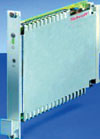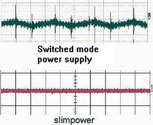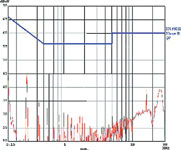
Developers and project engineers can tell many a tale about trying to find a suitable power supply for one's own particular application. Despite the fact that there is an enormous choice on the market, the one that exactly fits the bill is never amongst them. Compromises regarding dimensions, quality of output voltages, performance and price all have to be made.
Decisions between linear regulators and switch regulators
In measurement and control engineering especially, where a high quality of output voltage with minimal interference is of great importance, good advice is often expensive and difficult. Linear regulators do fulfil the demands, as they separate the input voltages via a transformer, stabilise them via a linear regulator, and filter them extremely effectively. However, they are large and heavy, with low efficiency. Switched regulators, however, work very efficiently, have small dimensions and weight. This is achieved by scrambling the regulated input voltages at high frequencies (50 to 500 kHz) and then galvanically isolating them with a small transformer. By regulation and filtration with the aid of a pulse-width regulator, the required output voltage is obtained.
Multiple voltage changes, do however, create interference, which can be found as ripples and spikes on the output voltages. The classic switch parts of a network have cost many developers a lot of time and expense in anti-interference measures.
Interference-low input and output voltage
With 'slimpower' Schroff has created a 19" power supply range that combines the positive properties of switched regulators as well as linear regulators. During the design and development of the power supplies, input and output voltages with the least possible interferences were taken into account, to lower the typical interferences of a switch regulator. The use of SMD performance components and planar technology reacts positively on the interferences due to the low parasitic effect. Ripples and spikes lie below the 10 mV tolerance for low emission units. At the same time, incoming interference has been reduced and with this, HF emissions also. The levels are at least 15 dB below the tolerance levels set by EN 55022 Class B.

Small dimensions, large performance
During development, further emphasis was put on small dimensions and high output performances. The units are arranged as a standard Euroboard, 3U and a depth of 160 mm (Euroboard format) and a width of 3 HP (15 mm) with a standard H15 connector. For the transformer instead of the common copper coils, etched copper channels, which have been placed on a board retainer by multilayer technology, are used. This multilayer construction fits exactly between two ferrite cores and saves a lot of space.

As the real primary switch regulator an integrated circuit is used for these power supplies and this element combines a complete pulse width modulator including the end phase. Cooling takes place via an SMD-cooling unit, which is thermally linked with flexible heat-conducting material to the housing of the power supply. Despite the small dimensions output performance of 5 V at 30 W, 12 V/15 V/24 V at 42 W in a temperature range between 0 to 50°C and an efficiency of 80% is achieved.

Depending on the application, these power supplies can be operated with or without redundancy diodes. During redundant operation, the current share operation guarantees an even distribution of power at the parallel switched ports. The V/I starting point for the parallel operation is configured 'hardly' or 'softly' and allows the user to run high capacity loads such as batteries with the unit. This is a considerable advantage for portable measuring instruments, for instance.
The indication of the output voltage is also configured as 'high active' and 'low active'. The secondary power limitation, over-voltage protection (OVP), which recurs on a cycle and the over-temperature protection, improves the function and safety of the power supplies. The MTBF values of these power supplies lie at more than 400 000 hours at 40°C. With a range of 85 to 254 V a.c. (120 to 360 V d.c.) worldwide use is possible.
| Tel: | +27 11 608 3001 |
| Email: | [email protected] |
| www: | www.actum.co.za |
| Articles: | More information and articles about Actum |

© Technews Publishing (Pty) Ltd | All Rights Reserved